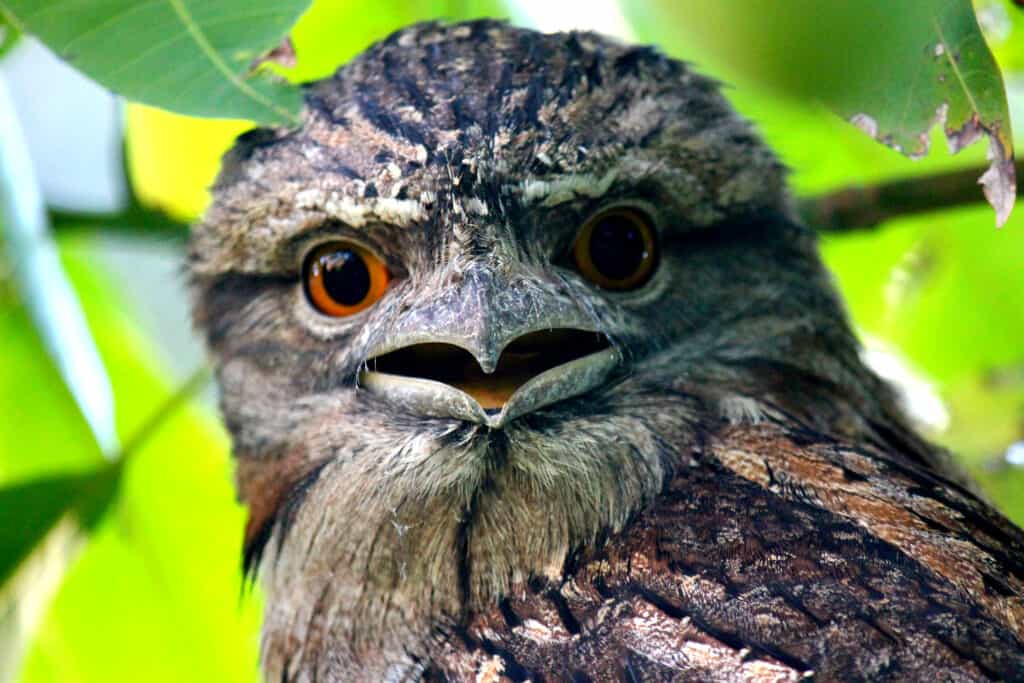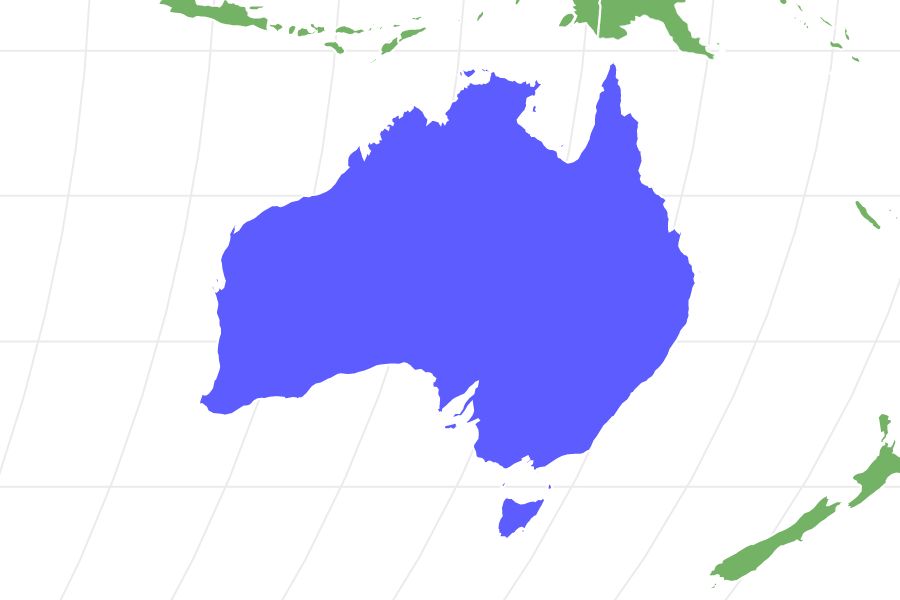Tawny Frogmouth
Podargus strigoides
The tawny frogmouth is a master of camouflage that can hide in plain sight!
Advertisement
Tawny Frogmouth Scientific Classification
- Kingdom
- Animalia
- Phylum
- Chordata
- Class
- Aves
- Order
- Caprimulgiformes
- Family
- Podargidae
- Genus
- Podargus
- Scientific Name
- Podargus strigoides
Read our Complete Guide to Classification of Animals.
Tawny Frogmouth Conservation Status
Tawny Frogmouth Facts
- Prey
- Frogs, reptiles, small mammals, small birds, insects, spiders, worms, snails, scorpions, centipedes, millipedes, other invertebrates
- Main Prey
- Nocturnal insects such as moths and beetles
- Name Of Young
- Chicks
- Group Behavior
- Pair
- Fun Fact
- The tawny frogmouth is a master of camouflage that can hide in plain sight!
- Biggest Threat
- Pesticides and habitat loss
- Most Distinctive Feature
- Streaky gray feathers, excellent for camouflage
- Distinctive Feature
- Wide, frog-like mouth; big yellow eyes; owl-like appearance; weak feet
- Temperament
- Still
- Wingspan
- 2 to 3 feet
- Incubation Period
- 28 to 32 days
- Age Of Fledgling
- 27 to 32 days
- Habitat
- Eucalyptus forests, Acacia shrublands, woodlands, heathlands, savannas
- Predators
- Cats, dogs, foxes, falcons, pythons, other snakes, ravens currawongs, butcherbirds, rodents
- Diet
- Carnivore
- Lifestyle
- Nocturnal
- Crepuscular
- Pair
- Favorite Food
- Insects
- Type
- Nocturnal insects like moths and beetles
- Number Of Species
- 1
- Location
- Australia
- Average Clutch Size
- 2
- Nesting Location
- In trees, about 3 to 10 meters above the ground
Tawny Frogmouth Physical Characteristics
- Color
- Grey
- Skin Type
- Feathers
- Lifespan
- Up to 14 years in the wild
- Weight
- 10 to 26 ounces
- Length
- 13 to 21 inches
- Age of Sexual Maturity
- 12 months
- Venomous
- No
- Aggression
- Low
View all of the Tawny Frogmouth images!
The tawny frogmouth is a master of camouflage that can hide in plain sight!
What superpower would you choose, silent flight or invisibility? Night vision or super hearing? The tawny frogmouth says, “All of the above, please!” This master of camouflage hides in plain sight during the day and hunts at night, gobbling up creatures that its human neighbors consider to be pests. It doesn’t fly around searching for a meal. Instead, it conserves energy, sitting and waiting on a branch until an unsuspecting morsel gets close. Then it pounces and grabs its prey in its powerful beak, or makes a quick and silent flight, catching it in midair. This stealthy bird might look like an owl, or a dead branch, but it is neither. It is, however, the “most instagrammable bird” in the world.
Incredible Tawny Frogmouth Facts
- Tawny frogmouths hunt by sitting and waiting for prey to come to them.
- These birds can stretch themselves out and look just like a tree branch.
- Tawny frogmouths build flimsy nests that often fall apart.
- Males incubate the eggs during the day, while females likely incubate at night.
- People appreciate these birds because they eat large quantities of pests.
- Tawny frogmouths are not owls.
- They may spray foul-smelling feces to confuse reptilian predators.
Where to Find Tawny Frogmouth
Tawny frogmouths are found throughout most of Australia, including the island state of Tasmania. They live in just about every sort of habitat except for dry and treeless desert regions and dense rainforests. Scientists believe that Australian frogmouths diverged from other known genera at least 30 million years ago, meaning the modern frogmouth species have a long history on the continent.
The tawny frogmouth lives in woodlands, primarily eucalyptus and acacia, in scrublands, heathlands, and savannas. It also lives in parks, gardens and other urban areas including backyards. It spends most of its time in trees, particularly mature trees with dead or rough branches.
People are more likely to hear tawny frogmouths than see them. They call loudly at night with a low and almost continuous, “oom-oom-oom.” However, you could be very close to one of these stealthy birds in broad daylight and never see it. They are so cleverly camouflaged and able to sit so very still, they practically disappear.
Tawny Frogmouth Scientific Name
One look at the tawny frogmouth will tell you where it got part of its name. The wide, frog-like mouth is common to this and other frogmouth species. The scientific name of this bird is Podargus strigoides. Strigoides is derived from the Latin word for owl. That makes sense because this bird looks a lot like an owl.
Podargus, the name of the bird’s genus, means “gouty.” The frogmouths in this genus were so named because of their feet, which are much more adapted to sitting than walking. They walk with a painful-looking gait like someone suffering from a case of gout. That’s okay, though, because they don’t spend much time on the ground.
There are three subspecies of tawny frogmouths. The subspecies P. s. phalaenoides lives primarily in northern Australia, P. s. brachypterus lives west of the Great Dividing Ridge, and P. s. strigoides lives east of the Great Dividing Ridge and in Tasmania.
Sometimes the tawny frogmouth is mistakenly called a “mopoke,” the nickname for the Southern Boobook owl. Although they share some similarities, the frogmouth is not an owl.
Tawny Frogmouth Appearance

Tawny frogmouths are not owls.
©L Twomey/Shutterstock.com
These birds vary in size and appearance based on the subspecies. The P.s. strigoides subspecies is the largest of the three. They can be anywhere between 13 and 21 inches in length and range from a little over 6 ounces to approximately 24 ounces in weight. Their wingspan averages between 2 and 3 feet.
The feathers of these birds are mostly gray, with white streaks and light barring. Some females are a bit more chestnut or rufous colored. The best way to describe their coloration would be the appearance of old tree bark, because tawny frogmouths can blend in almost seamlessly with the limbs of mature trees.
The birds have big, yellow eyes and wide curved beaks. The insides of their mouths are bright yellow, or yellow-green, and they present a gaping mouth display to frighten or distract other birds or predators. Their legs are short, and their feet are weak, especially as compared to the powerful talons of owls.
These birds do resemble owls closely enough that many people get confused, but it bears repeating, they are not owls. They are members of the nightjar family and are closely related to nighthawks and whip-poor-wills.
Tawny Frogmouth Behavior
This bird is mainly nocturnal or crepuscular, meaning it is most active at night or in the twilight hours of dusk and dawn. It hunts at night using a sneaky sit and wait approach, waiting and watching for prey to come near, then pouncing down upon it or chasing it through the air.
During the day, it spends much of its time sleeping, but usually with one or both eyes slightly open to watch out for predators. When it is awake during the day, the bird spends time with its mate, grooming each other, taking turns guarding their territory, or working together to raise their chicks.
This silent sitting approach works well for the tawny frogmouth, thanks to its amazing camouflage. If the bird senses a threat, it takes stealth to another level. It stretches its body out, tightens its feathers and holds a pose, completely still, so that it looks just like a dead branch. Predators are often fooled, as evidenced by the bird’s long lifespan in the wild.
Surviving the Cold
In the winter, tawny frogmouths use a few techniques to survive the cold. They huddle together to conserve heat. They also position themselves on branches in direct sunlight to absorb as much heat as possible. On especially cold nights, when food is scarce, they enter a state of torpor for a period of a few hours between dusk and dawn. During torpor, they reduce their metabolism and temperature significantly to reduce their energy consumption before arising to hunt again, usually close to daybreak.
Diet
The tawny frogmouth hunts mainly at night and in the twilight hours. Although people often mistake this nocturnal bird for an owl, its hunting style differs significantly. Instead of flying through the air and snatching prey with its feet, the tawny frogmouth uses its large beak exclusively for catching food. Sometimes it flies and catches nocturnal insects like moths in midair. Other times it sits and waits patiently in a tree until an unsuspecting creature comes close, and then it pounces down and grabs it with its beak.
Humans appreciate this bird for eating large quantities of prey that are considered pests, especially the swarming Christmas beetles that strip eucalyptus trees. They eat all sorts of insects, including moths, cockroaches and beetles. They also devour spiders, centipedes, millipedes, scorpions, slugs, snails and other invertebrates. Tawny frogmouths are also known to eat small rodents, lizards, frogs and even other birds.
Tawny Frogmouth Reproduction
These birds form monogamous pairs that live together for many years. When they are not hunting, they spend most of their time together, leaning against each other, roosting side by side and grooming one another. They stay together in the same territory for years.
Both the males and females work together to build a nest of twigs and leaves about 3 to 10 meters above the ground. It is not a sturdy nest, but more of a loose pile of material in the fork of a tree. The nests often fall apart, and younger chicks in a brood are prone to falling to the ground.
Pairs usually have only one brood per year, with one to three eggs. Breeding takes place in the Australian spring, usually from August through October. Both the male and female incubate the eggs, with the male sitting on the nest during the day. Incubation lasts about a month.
Juveniles are lighter colored than their parents and easier to see, so the parents hide them underneath their own bodies to protect them from predators. Nest predation is still a constant threat, and although both parents feed and guard their young, nestling mortality is high.
Fledglings leave the nest after about 27 to 32 days, but they stay close to their parents for some time before dispersing, usually during their first summer. They reach sexual maturity at about 12 months of age and begin the search for a mate of their own.
Predators
Tawny frogmouths are susceptible to predators as adults and in the nest. The most dangerous time for an adult is when it flies to the ground to catch prey. Domestic cats are the bird’s primary predator, but dogs, foxes, falcons and pythons are also deadly foes.
Pythons and other snakes also prey on juveniles and eggs in the nest. So do ravens, currawongs, and butcherbirds. The lace monitor lizard, a fearsome reptile more than six feet long, is also known to climb trees and attack tawny frogmouth nests.
The tawny frogmouth’s main defense against predators is camouflage. If they can avoid detection by staying very still, or by hiding their nestlings under their own bodies, they will. Otherwise, they will use defensive displays, such as opening their mouths wide to flash the bright yellow insides, erecting spiky-looking feathers around their heads, and clacking loudly. They are also not above spraying foul-smelling feces to confuse reptilian predators.
Lifespan of the Tawny Frogmouth
This bird lives as long as 14 years in the wild, and some individuals have survived more than 30 years in captivity. Although its population is undetermined, it is considered stable and the species is listed as least concern by the IUCN Red List.
Besides predators, three factors are considered the greatest threats to tawny frogmouths. Pesticides are a particular danger, especially those used on rodents, because the poisons consumed by prey end up ingested by the predator, too.
Fires are another threat affecting this bird, mainly because it is so staunchly territorial. Individuals stick to the same territory for many years, and they have a hard time picking up and relocating even when disaster strikes.
Finally, cars are perhaps the greatest threat to the tawny frogmouth. When the urban dwelling birds hunt at night, chasing a moth or other prey, they often fly low across roads. Car strikes are common and end the lives of many birds.
Most Instagrammable Bird
A 2021 research study on bird photography and social media found that the tawny frogmouth is the world’s “most instagrammable bird.” This study referenced 20,000 photos of birds on the Instagram platform and compared their numbers of likes relative to their level of exposure. Just a few years earlier it had been dubbed “the world’s most unfortunate-looking bird.” Some people think the bird is irresistibly adorable, while others think it is just plain ugly. But love it or hate it, the tawny frogmouth is definitely something to see.
Similar Animals
- Common Nighthawk – The common nighthawk is a crepuscular member of the Caprimulgidae family that is native to North America.
- Kookaburra – The kookaburra is an Australian kingfisher that shares range and habitat with the tawny frogmouth.
- Carpet Python – The carpet python, an Australian snake that is one of the most common predators of the tawny frogmouth.
Tawny Frogmouth FAQs (Frequently Asked Questions)
What does the tawny frogmouth look like?
The tawny frogmouth looks like an owl or a dead tree branch. But it is neither of those. It is a chunky bird with mostly gray feathers, white streaks and light barring. It has big yellow eyes and a wide, hooked beak. Its legs are short and its feet are weak compared to the large and powerful talons of an owl.
What does a tawny frogmouth chick look like?
Baby tawny frogmouths are lighter gray than their parents and very fluffy.
How big are tawny frogmouths?
They can be anywhere between 13 and 21 inches in length and range from a little over 6 ounces to approximately 24 ounces in weight. Their wingspan averages between 2 and 3 feet.
How many varieties of tawny frogmouths exist?
There is only one tawny frogmouth species, Podargus strigoides. There are three subspecies, including P. s. phalaenoides, which lives primarily in northern Australia, P. s. brachypterus, which lives west of the Great Dividing Ridge, and P. s. strigoides, which lives east of the Great Dividing Ridge and in Tasmania.
What makes the tawny frogmouth special?
The tawny frogmouth is a master of camouflage. It can stretch itself out and hold perfectly still, looking exactly like a tree branch.
When did the tawny frogmouth originate?
The tawny frogmouth and other Australian frogmouths likely diverged from species in other parts of the world approximately 30 million years ago.
Where do tawny frogmouths live?
The tawny frogmouth lives across most of Australia, including the island of Tasmania, except in the very dry and treeless desert regions and dense rainforests. It lives in woodlands, primarily eucalyptus and acacia, in scrublands, heathlands, and savannas. It also lives in parks, gardens and other urban areas including backyards.
Do tawny frogmouths mate for life?
Tawny frogmouths are monogamous and do mate for life. They spend most of their time together, even roosting side by side on the same branch and leaning on each other.
What do tawny frogmouths eat?
Tawny frogmouths eat all sorts of insects, including moths, cockroaches and beetles. They also devour spiders, centipedes, millipedes, scorpions, slugs, snails and other invertebrates. They are also known to eat small rodents, lizards, frogs and even other birds.
How long do tawny frogmouths live?
Tawny frogmouths live approximately 14 years in the wild, but individuals have been known to live more than 30 years in captivity. Their greatest threats are cars, fire, pesticides and predators such as cats, dogs, foxes and snakes.
Are tawny frogmouths rare?
Tawny frogmouths are not rare. Although their exact numbers are unknown, the population is considered stable and they are listed as a species of least concern on the IUCN Red List.
Thank you for reading! Have some feedback for us? Contact the AZ Animals editorial team.
Sources
- Billabong Sanctuary Townsville, Available here: https://www.billabongsanctuary.com.au/tawny-frogmouth/
- Queensland Museum Network, Available here: https://blog.qm.qld.gov.au/2020/05/18/birds-of-the-lost-arcs/
- University of New England, Available here: https://rune.une.edu.au/web/handle/1959.11/232
- San Diego Zoo Wildlife Alliance Library, Available here: https://ielc.libguides.com/sdzg/factsheets/tawny-frogmouth
- Sage Journals / Katja Thömmes https://orcid.org/0000-0003-0120-5289 / Katja Thoemmes and Gregor Hayn-Leichsenring, Available here: https://journals.sagepub.com/doi/full/10.1177/20416695211003585

















